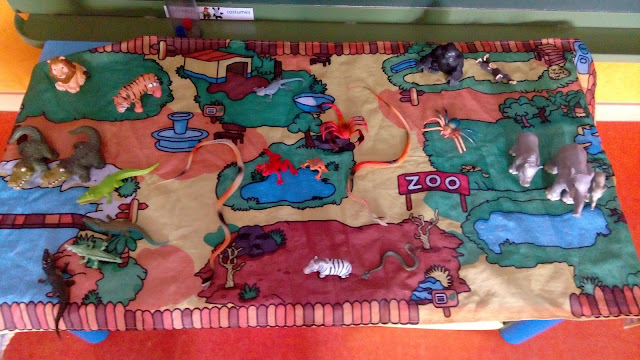1. Encuentro
En primer lugar nos quitamos las zapatillas y nos sentamos en un círculo. Y realizamos una rueda de autodiagnóstico: cerramos los ojos y respiramos profundamente. Hacemos una breve mirada hacia el interior y el que quiere comparte con los demás cómo se encuentra en ese momento.2. Preparación respiratoria
Realizamos ejercicios de respiración con la intención de tomar conciencia de los tres niveles respiratorios (abdominal, costal y clavicular), así como de sus cuatro fases que simbolizamos con un cuadrado imaginario, en el cual cada lado simboliza una fase: expulsión, retención a vacío, inspiración y retención a lleno.
3. Preparación corporal
Se movilizan los músculos y articulaciones del cuerpo para poder activarnos y de este modo comenzar la práctica con una buena preparación.
4. Karanas y asanas
En esta sesión, las karanas y asanas que vamos a realizar van a ir de la mano de un cuento motor inventado que iremos dramatizando por medio de diversas posturas.
Vamos caminando por un bosque en el Moncayo, con mucho cuidado (de puntillas) para no pisar a las hormigas, llegamos a una llanura en la que de repente apareció un hada que nos dijo: "patatal, patatil, patatol....que todos los niños se conviertan en árbol".
Éstos árboles eran altos y fuertes, durante el verano habían estado llenos de hojas, pero ahora que había llegado el otoño se empezaron a caer todas al suelo. Y...."patataja, patateja, patatoja...que todos los niños se conviertan en hoja" (postura del bebé).
En esta época del año empieza a levantarse un poco de aire y cada vez más y más hace que las hojas se bamboleen y que al final todas se levanten. Y..."patatara, patatera, patatero...que llegue el viento al mundo entero". (helicóptero)
Pero no solamente empieza a hacer más cierzo en otoño, además también comienza a llover algún día más. Y..."patatava, patateva, patativia...que venga la lluvia". (esquiador)
Con tanta lluvia, se ha formado un estanque en el bosque en la que las gotas han ido cayendo una detrás de otra sin parar. Pero de repente aparece la bruja Maruja y..."patatena, patatina, patatana...que todos se conviertan en estatua de rana". (malasana)
5. Relajación
Realizamos una breve relajación:
Cuando el hada se enteró de lo que había pasado vino a liberar a las ranas del embrujo, pero se habían quedado helados de frío. Necesitaban ponerse el pantalón largo, la chaqueta y hasta el abrigo!
Cuando el hada se enteró de lo que había pasado vino a liberar a las ranas del embrujo, pero se habían quedado helados de frío. Necesitaban ponerse el pantalón largo, la chaqueta y hasta el abrigo!
Finalmente bien abrigaditos nos vamos de vuelta a casa caminando por ese precioso bosque con una gran alfombra amarilla y marrón, comenzamos a recoger hojas y hacemos una pila sobre la que nos tumbamos y hacemos "el ángel". Inmersos en una gran lluvia de hojas.
Hacemos una rotación de conciencia: y nos vamos imaginando como se nos va cubriendo de hojas los pies, las piernas, la tripa, el pecho, el cuello, la boca, los ojos 6y hasta la frente. Sumiéndonos en una gran relajación, fundiéndonos con la naturaleza.
6. Concentración
Tratamos de tomar conciencia de la sesión, cómo nos encontramos, si hemos aprendido algo, etc
Para ello estamos unos minutos en silencio disfrutando del momento presente y utilizando distintas técnicas como rotación de conciencia (repaso de las partes del cuerpo invitándolas a la calma), o visualizaciones creativas u otras técnicas de meditación.
Para concluir hacemos un círculo de nuevo y nos preguntamos cómo estamos ahora después de la sesión de yoga. ¿Ha cambiado algo en nuestro interior?
Y terminamos con un abrazo y dándonos las gracias.
Y terminamos con un abrazo y dándonos las gracias.















































